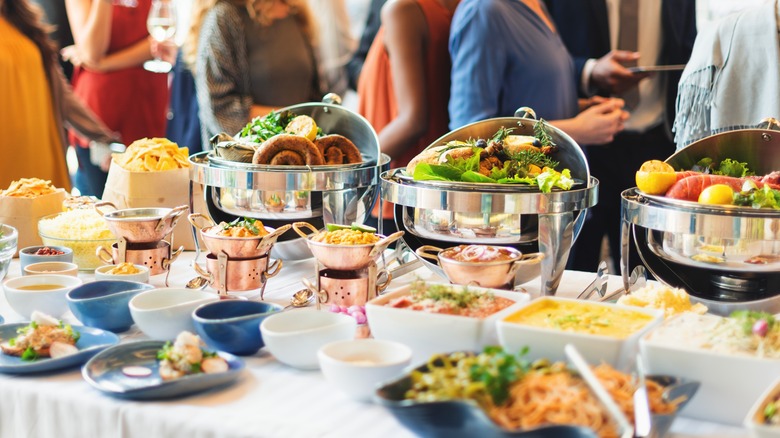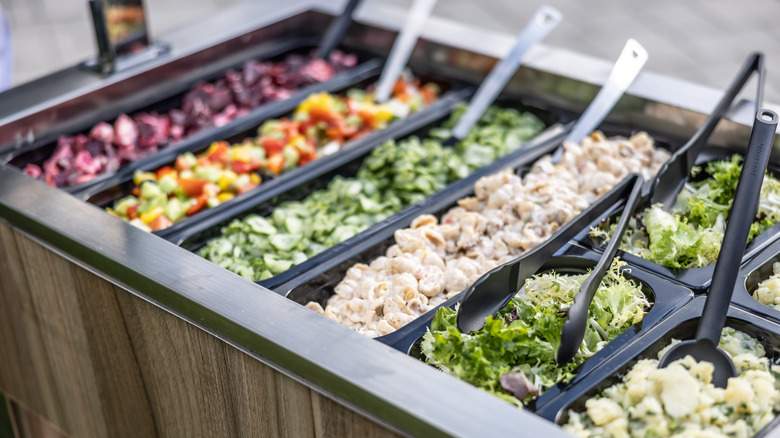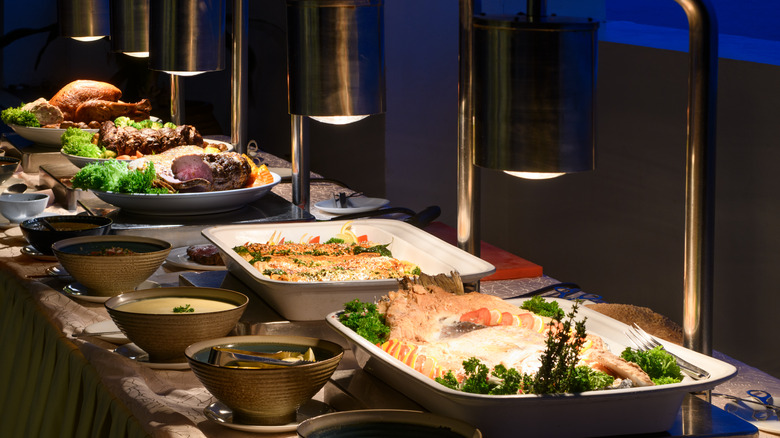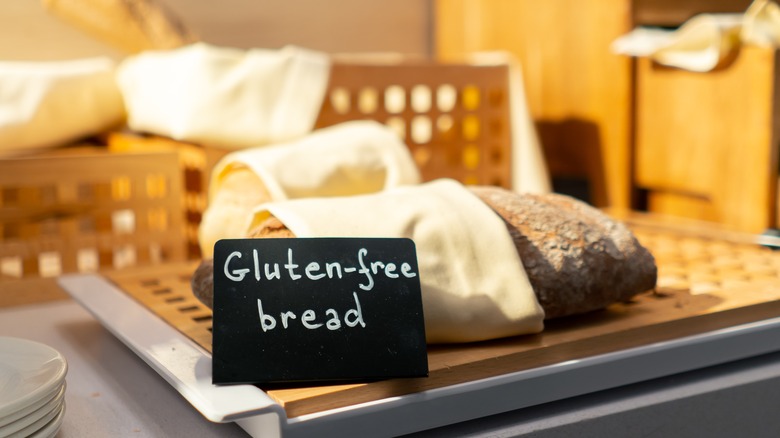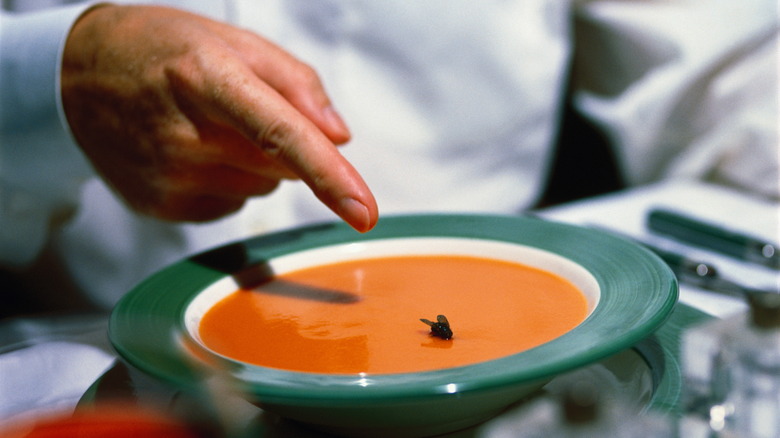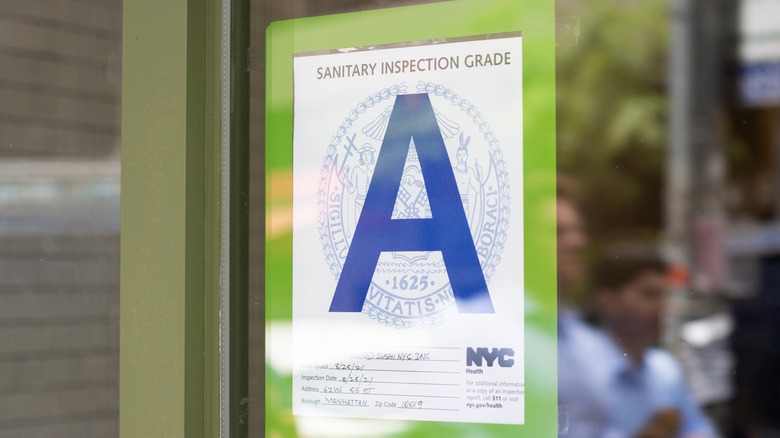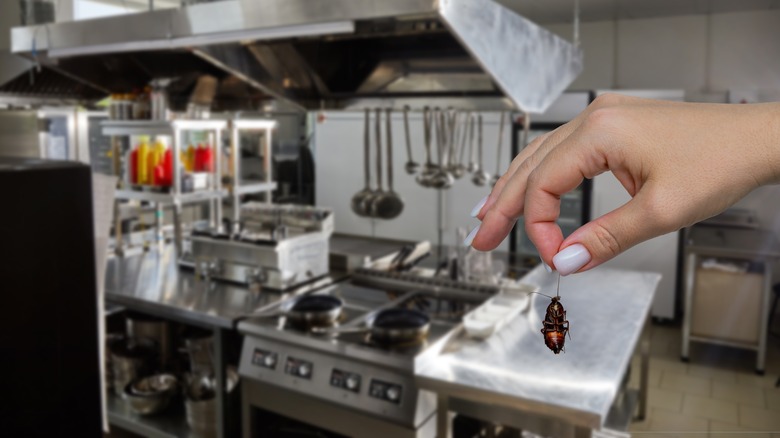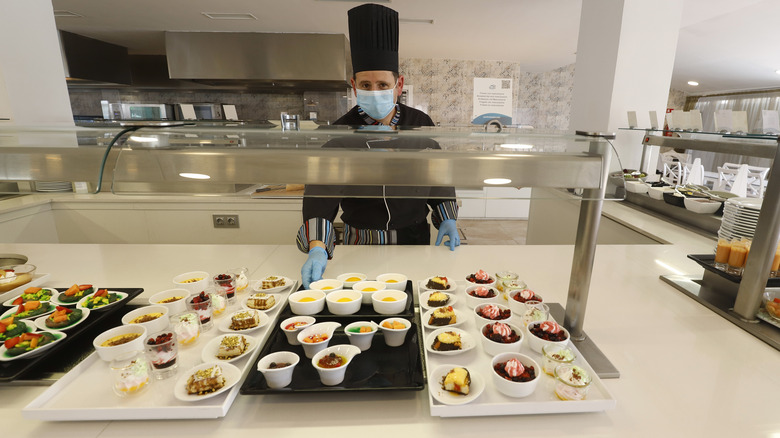12 Red Flags You Should Look Out For At A Buffet
Who doesn't love loading up a plate at an all-you-can-eat buffet? The strategy of plotting your route, hitting the expensive stuff first, grabbing a little of everything to find your favorites. There's something uniquely satisfying about getting unlimited access to dozens of dishes for one fixed price.
But beneath that gleaming sneeze guard lurks potential danger. According to the Centers for Disease Control and Prevention (CDC), 1 in 6 Americans contracts a food-borne illness each year, and buffets create unique opportunities for contamination that regular restaurants don't face. While a traditional restaurant keeps food preparation under tight control, buffets put food out in the open where it faces temperature fluctuations, potential contamination from other customers, and extended exposure time. Even though customers play a role in buffet safety, the primary responsibility falls on the restaurant to maintain proper standards and protocols.
If you notice just one concerning sign at a buffet, it might not be cause for alarm. But when multiple red flags start popping up, it's probably time to reconsider your dining choice. Here are warning signs that could save you from a very uncomfortable aftermath to your all-you-can-eat experience.
Servers not doing their jobs
Think a buffet means no need for staff? Think again. The servers at a buffet actually play a crucial role in food safety, and how they behave can reveal a lot about what's happening behind the scenes. Buffets come with higher food poisoning risks than traditional restaurants, which is why good places keep their standards extra high. The FDA recommends at least one server should be monitoring the buffet at all times. These folks aren't just clearing your dirty plates. They're keeping an eye on how customers handle the food, tracking how long dishes have been sitting out, watching for cross contamination, cleaning up spills quickly, and swapping out serving utensils regularly. Don't try to do their job for them: If you spill something at the buffet, leave it for a server to clean it up.
Look for servers who seem alert and on top of things. Are they actively watching the buffet area or just hanging out by the kitchen door? Good servers will be wearing clean gloves and changing them frequently between tasks. Their uniforms should be spotless, no food stains or mysterious splatters. This attention to personal cleanliness usually reflects how they treat the food, too.
The overall vibe of the staff tells you volumes about a restaurant's safety culture. If servers seem frazzled, if nobody's monitoring the food, or if the whole operation feels chaotic, that's a pretty solid clue that food safety isn't their top priority. Remember, what happens out front usually reflects what's happening in the kitchen. Calm, attentive servers typically mean a well-run kitchen that takes food safety seriously.
Not enough utensils
A well-run buffet maintains a strict one utensil per dish policy without exception. This is crucial to prevent cross-contamination between different the different dishes. Quality buffets keep an ample supply of clean replacement utensils ready at all times. Staff should be vigilantly monitoring the serving stations, quickly swapping out any utensil that has touched a contaminated surface, fallen into the food, or been used to mix a dish. When a serving spoon or tong handle becomes submerged in food, it creates a pathway for bacteria to transfer from hands to the entire dish. The type of utensils provided also matters. Unfortunately, some restaurants try to cut corners by providing shorter utensils, ostensibly to limit portion sizes, but this can increase contamination risks as hands come closer to the food.
Despite the best efforts of restaurant staff, fellow diners pose one of the biggest contamination risks at any buffet. While employees receive food safety training, the general public often demonstrates concerning behaviors. Without adequate utensils readily available, some customers might grab food with their hands, use the wrong utensil, or return a dropped utensil to a dish.
A conscientious buffet anticipates this by ensuring proper utensils are always available and correctly positioned. Before filling your plate, take a moment to assess the utensil situation. If you notice missing utensils, shared utensils between dishes, or handles submerged in food without staff intervention, consider these significant red flags regarding the overall food safety standards of the establishment.
Is the food being kept at the right temperature?
Temperature control stands as one of the most critical safety factors at any buffet. Food safety experts identify the range between 40 F and 140 F as 'the danger zone where harmful bacteria multiply most rapidly. At optimal growth temperatures around 98 F (coincidentally human body temperature), bacteria like salmonella, E. coli, and staphylococcus aureus can double in number every 20 minutes.
Hot foods should maintain temperatures of at least 140 F, typically achieved through properly functioning chafing dishes, slow cookers, heat lamps, or warming trays. Watch for visual cues that hot food is actually hot, such as steam rising from dishes, bubbling sauces, or heating elements that are clearly activated. If food looks dried out or has a film on top, it has likely been sitting at inadequate temperatures for too long. Cold foods require temperatures below 40 F. Quality buffets accomplish this by displaying cold items in ice baths or using refrigerated cases. Dairy products, seafood, and meat are particularly vulnerable to temperature abuse and require vigilant monitoring.
Well-managed buffets serve food in small batches that are frequently replaced rather than continuously topped off. This ensures food spends minimal time in the danger zone. Large, full trays that remain unchanged throughout service suggest food has been sitting too long at potentially unsafe temperatures. Before adding anything to your plate, take a moment to assess whether hot foods are genuinely hot and cold foods are properly chilled. Properly maintained temperatures remain the most reliable indicator of a buffet's commitment to food safety.
Food sitting out for a long time
Spotting a sign that limits buffet service to just two hours might initially seem inconvenient, but it is actually a good sign. When a restaurant keeps its buffet to a tight window, it's usually showing it cares about keeping food safe to eat. Food safety standards specify that perishable foods should not remain at room temperature for more than two hours. This guideline isn't arbitrary but based on microbial growth patterns. After two hours in room temperature, harmful bacteria can multiply to dangerous levels.
Several visual cues can help determine how long food has been sitting out. Fresh food typically maintains vibrant colors, while items that have been out too long often appear dried out, discolored, or develop a film on top. Sauces and gravies may show signs of separation or skin formation. Foods like lettuce wilt, fried items become soggy, and once-crisp vegetables turn limp.
Good buffet spots that stay open longer have proper ways to keep food safe. These include using smaller serving containers that are completely replaced rather than topped off, strict temperature monitoring, and designated staff responsible solely for rotating food.
The serving dishes are being added to rather than replaced
You'll know you're in trouble when you see staff dumping fresh food right on top of the crusty remains that have been sitting out forever, then giving it a lazy stir until everything mushes together. This isn't just gross, it's a huge red flag that they don't care about health codes, and who knows what other corners they're cutting.
Here's why this matters: Old food sitting out can be loaded with nasty bacteria like salmonella and E. coli. When they mix it with fresh stuff, they're basically spreading those germs to perfectly good food. Some foods are especially risky when mishandled, stuff like sprouts, leafy greens, rice, soft cheeses, lunch meats, chicken, and all seafood. These need extra careful handling to stay safe. One of the nasty strains of bacteria that loves hanging out in food that's been sitting out for too long is clostridium perfringens. Catch this bug and you won't throw up, but you'll spend about 10 hours with stomach cramps, nausea, and diarrhea. Not exactly the souvenir you want from your buffet visit.
Not having enough clean plates
Using the same plate for seconds at a buffet might seem helpful, fewer dishes to wash, right? Wrong. This common mistake actually breaks important FDA guidelines. Good buffets make sure you don't do this, either by having staff remind you, or putting up signs. Restaurants can even lose points on health inspections if they don't enforce clean plate usage.
A decent buffet will always have plenty of clean plates ready to go, usually stacked right at the beginning of the food line. Keep an eye on how they handle busy times, if they're constantly running out of clean plates or don't seem to care when people reuse plates, that's a pretty good clue they're cutting corners on other safety rules, too.
It's not properly signed
A good buffet should be well signed. According to FDA guidelines, buffets need three types of signs at minimum to meet basic requirements. Firstly, there should be clear signs telling you to grab a clean plate for your second helping. It's not just a courtesy thing, this is actually a serious food safety rule. Second, anywhere they're serving raw stuff like meat, eggs, fish, or shellfish, they need warning signs about the risks of consuming these items. And third, those cereal dispensers and other bulk foods? They should either show the manufacturer's label or have a list of ingredients and allergens available for anyone who asks.
If these basics are missing, you're dealing with a place that's ignoring FDA rules. And let's be real, if they're skipping these simple requirements, what else are they letting slide? Some really good buffets go beyond the minimum. They'll post friendly reminders like 'Please use tongs provided' to stop folks from grabbing food with their hands (we all know that one person who does this). Others have signs asking parents to supervise young children at the buffet. These extra touches show management that actually cares about keeping everything safe and clean. Before loading your plate, take a quick scan of the signage. Those little placards tell you a surprising amount about how seriously a buffet takes both food safety and customer care.
The food is looking funky
Take a good look at the food on offer and don't be too forgiving about the quality of what you pick up. Use your common sense and pay attention to things like smell, texture and appearance. If fish or meat has a sour or ammonia-like smell, just walk away. No amount of hunger is worth that risk. Look out for unusual textures. Crusty edges might seem like a minor issue, but they're telling you that dish has been sitting out way too long. Same goes for liquids separating from solids or oils pooling on top, classic signs that food has been hanging around past its prime.
Watch out for that slimy film on deli meats. That's not some fancy sauce or glaze, it's bacteria throwing a party on your potential lunch. And those rock-hard dinner rolls? They're not 'extra crispy,' they're just plain old stale. When a buffet can't be bothered to replace basic bread items, they're probably cutting corners elsewhere too.
The salad bar deserves special attention. Fresh produce should look, well, fresh. Lettuce should be crisp and vibrant, not wilted and sad. This isn't just about taste, it's about safety. Raw foods like lettuce are high-risk items for contamination.
It doesn't have good grades
Want a super simple way to check if a buffet is safe before you even walk in? Look up the spot's food safety grade. Some places like New York require restaurants to display their grade right in the window where you can see it. In other states, you'll need to look it up online before you go. It takes just a minute but can save you days of stomach trouble.
An A grade means the place is running a tight ship with little to no food safety concerns. Having a B grade isn't necessarily a deal-breaker. This common rating means there are some minor violations that need fixing, but the restaurant should still be safe. Smart diners can check what the specific violations were to decide if they're concerning or not. Now, if you spot a C grade? That's a huge red flag. When health inspectors find problems, they give restaurants a chance to fix them. A C grade means not only did they have serious violations, but nobody bothered to correct them, and management was fine with that. Yikes.
The overall cleanliness is questionable
Before you even pick up a plate, take a moment to scan the entire space and assess the overall cleanliness of the restaurant. Check floors for stickiness, tables for residue, and windows for smudges. Inspect glassware for spots and staff uniforms for stains. Pay attention to any unpleasant odors. Musty smells, lingering bleach, or sour scents often signal poor cleaning practices. Most importantly, examine food stations themselves, they should be free from splatter and old food debris.
Take a quick detour to the restroom before filling your plate, it'll tell you more about a restaurant's standards than any Yelp review. Spotlessly clean facilities with stocked supplies reflect a management team that sweats the details. Meanwhile, grimy sinks, mystery puddles, and empty soap dispensers reveal the uncomfortable truth, that this place lacks basic hygiene protocols.
Pay special attention to the lighting. Suspiciously dim restaurants might be hiding cleanliness issues. The FDA food code requires food service areas to have illumination of at least 215 lux (about as bright as a living room). Proper lighting isn't just for ambiance, it allows both staff and customers to see whether surfaces are actually clean.
If they've given up on maintaining clean spaces where customers can see, it's difficult to imagine higher standards being maintained behind kitchen doors. When multiple cleanliness red flags appear, the safest choice is simply to find somewhere else to eat.
Servers not wearing gloves
Food service workers can easily transmit viral pathogens without realizing they're infected. Many food-borne pathogens have a remarkably low infective dose, meaning even a tiny amount can make customers sick. Proper glove usage creates an important barrier between these potential pathogens and the food customers consume.
Gloves should be changed at least every four hours even when performing the same task, as this timeframe gives bacteria enough time to multiply to dangerous levels. More importantly, gloves must be changed between different tasks to prevent cross-contamination. A red flag to look out for are seeing staff touch their face, hair, clothing, or phone while wearing gloves and then continuing to handle food. Another warning sign is servers who handle raw ingredients and then ready-to-eat foods without changing gloves in between. Staff should never handle money or clear dirty dishes wearing the same gloves they use for food service.
The proper protocol requires servers to wash their hands thoroughly before putting on a new pair of gloves. This step is crucial because contaminated hands can transfer pathogens to the outside of clean gloves during application. Keep an eye out for staff who simply snap on new gloves without washing first. If gloves become torn, soiled, or if a worker is interrupted during their task, those gloves should be discarded immediately. Buffets with conscientious food safety practices will have boxes of fresh gloves readily available at various stations to encourage frequent changing.
There aren't sneeze guards
Those transparent shields protecting buffet food are actually federal requirements, not just an aesthetic choice by the restaurant. These protective shields create a physical barrier between customers and food, helping to prevent contamination from airborne particles. When people cough, sneeze, or even talk, they release tiny droplets that can travel through the air. Even healthy individuals can carry germs like staphylococcus aureus that, once transferred to food, can grow and produce toxins that cause illness.
A proper sneeze guard should extend beyond the edge of the food container and be positioned at the right height to block the direct line between a typical person's mouth and the food below. The guard should cover the entire length of the food display without gaps or missing sections. Be wary of buffets with sneeze guards that are too high, too short, or positioned at awkward angles that don't actually shield the food. Watch out for red flags like dirty or smudged sneeze guards, cracked or broken guards that haven't been replaced, or sections of the buffet missing guards altogether. These issues suggest the establishment isn't taking basic food safety measures seriously.
Equally concerning are fellow diners who find ways to bypass these protections. Customers reaching around or under sneeze guards, leaning over barriers to inspect food, or allowing children to duck under the guards all defeat the purpose of these safety measures. A quality buffet will have staff monitoring and gently correcting such behaviors.

